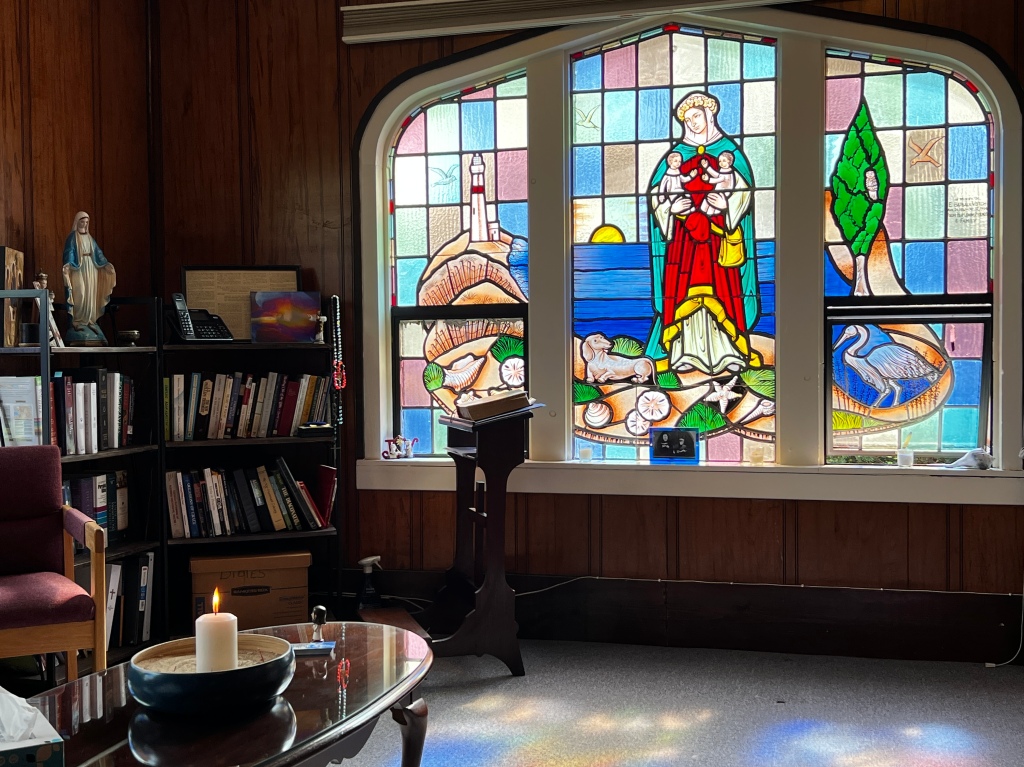Nowadays, people often do not take time to reflect on their faith. Instead, they’re rushing from one thing to the next without ever taking a second to stop and take in what’s going on around them, yet Christianity is a faith that begins in prayer. The Bible tells us to “Pray without ceasing.”
Contemplative prayer is a way to help us take the pause we need.
In this short space, I want to explore what it means to hold a consistent practice of contemplative prayer as a Christian. For those who may not know, contemplative prayer is a way of communicating with God in a way that focuses on wonder, awe, and mystery. Instead of asking for something or telling God how we feel, we focus on God and God’s presence. By doing this, we can come into the present moment and connect with the power of the Holy Spirit. This type of prayer leaves an imprint on our hearts and in our souls that helps us better discern God’s presence in our life –and become more aware of where the Spirit is leading.
Contemplative Prayer as a Christian Practice
In Christianity, contemplative prayer and meditation is not a new or novel concept. In every era, some pray in a meditative manner. Our Desert Fathers and Mothers of Egypt, Palestine, and Syria, St. Augustine and St. Gregory the Great in the West, and Pseudo-Dionysius and the Hesychasts in the East were the first to put contemplative prayer into practice.
St. Bernard of Clairvaux exemplified the Christian contemplative tradition in the Middle Ages. St. Hildegard, St. Mechtilde, Meister Eckhart, Ruysbroek, and Tauler were all Christian Contemplatist. Additionally, the author of The Imitation of Christ, Thomas Kempis, and fourteenth-century English mystics such as the author of The Cloud of Unknowing, Walter Hilton, Richard Rolle, and Julian of Norwich, contributed to the Christian contemplative legacy.
Before and following the Reformation, the Carmelites of Saint Teresa, St. John of the Cross, and St. Therese of Lisieux, the French school of spiritual writers, and the Jesuits, particularly Fathers De Caussade and Lallemont, all engaged in what they referred to as “spiritual practices” in their daily lives. These techniques were also observed by Benedictines such as Dom Augustine Baker and Dom John Chapman, as well as modern Cistercians such as Dom Vital Lehodey and Thomas Merton.
Contemplative prayer is a way of communicating with God in a way that focuses on the awesome power of God with all the wonder of our hearts. It is about focusing on God alone and God’s presence in our life instead of asking for something or telling God how we feel. By doing this, our prayer leaves an imprint on our hearts and soul.
You might be wondering, “What exactly is contemplative prayer?” It is a Christian practice grounded in the belief that we are all made in God’s image and likeness. As such, we want to be as Godlike as possible. We want to live Holy lives. Contemplative prayer assists us in being in the present moment, seeing things as they really are, and jumping into the mystery of who God truly is.
Examples of contemplative prayer:
- Centering prayer
- Meditation, sitting quietly, attentively waiting for the Spirit to speak
- Mantra Meditation
- Lectio Divina
- Visio Divina
TIPS:
- use your senses as prompts for prayer (e.g., textures, smells, tastes, sounds)
- Let go of expectations and selfishness during prayer time
- pray without words or one-word mantra
- pray without ceasing
Contemplative prayer is a form of communication between you, God, and the Holy Spirit. You are listening to God, and God is communicating with you through the power of the Holy Spirit. You are resting in God’s Holy presence.
So often, when we pray, we are thinking about what we want or need from prayer. We are thinking about why we are praying instead of being present in the moment. Contemplative prayer helps us come into the present moment and see things from a whole new perspective.
This type of communication is not easy–it takes practice.
One way that people start this practice is by setting aside sacred space—a place where you feel safe, quiet, and at peace. For example, it may be a space where you like to sit and read.
Another idea for a busy mind is writing down your prayers before you enter into contemplation, letting them go and allowing the space for the Holy Spirit to respond.
Another way to start is to practice contemplative prayer slowly by taking it a step at a time. Start with short moments of about five to ten minutes, then work your way up to sitting in God’s presence for twenty to thirty minutes. Eventually, the time will go by so quickly that even an hour will be simple and refreshing for your Spirit.
All of this helps your communication with the Divine become more meaningful–and more effective–in the future! You are deepening your relationship.
What is the Difference Between Contemplative Prayer and Other Types of Prayer?
Contemplative prayer is different from other types of prayer because you are resting in God’s presence with a focus on God’s great power and mystery. We notice our body, our breath, and all our senses. We submit ourselves to the Holy Spirit in a sacred space. In this type of prayer, you are less likely to ask for something or tell God how you feel. Instead, you focus on Him and His presence.
This type of prayer is not only a way for us to communicate with God, but it’s also a way for us to be more present in the moment and have clarity in our everyday discernment.
Additional types of Christian Prayer
Blessing and Adoration is a form of prayer that praises God.
Prayer of Petition, which is most familiar, is a form of prayer in which we ask God for a particular need or direction. We bring our worries, concerns, and needs before the cross.
Prayer of Thanksgiving is a prayer of gratitude, recognizing and appreciating all of God’s gifts in our lives.
Corporate prayer is a type of prayer is where Christians come together to worship God through song, reading the Bible, and more. This type of Christian practice allows Christians to build community with one another while growing in their faith. (Though I argue that there is a deepening of community relationships when contemplation happens among you in small groups)
Intercessory prayer occurs when a person prays to God for someone else’s needs or desires. Intercessory prayers can be offered by individuals or groups–both of whom are praying for the same intention.
Reasons to Practice Contemplative Prayer
“When he taught his disciples how to pray, Jesus told them: “Go to your inner room, close the door, and pray to your Father in secret. And your Father who sees in secret will repay you.” Matthew 6:6
Contemplative prayer is a unique and wonderful way to communicate with God. It’s not that we can’t talk to God any other way, but contemplative prayer is a special and unique moment for us and our Father in Heaven.
So, what are some reasons why you should consider practicing contemplative prayer? Here are six:
- Prayer becomes more intimate
- Contemplative prayer helps us to recognize ourselves as God sees us
- Contemplative prayer helps us to notice the world with Holy vision.
- Prayer becomes less about getting what we want and more about giving to others
- Contemplative prayer creates space for reflection and self-awareness
- Prayer becomes less about feeling better and more about creating beauty in the world
How to Do Contemplative Prayer
Contemplative prayer can be done in a variety of ways. Not everyone does it the same way, and that’s perfectly fine! However, some common ways to do contemplative prayer include:
- Repetitive Prayer or Mantra Meditation: Repetitive prayer is when you pray the same thing over and over again, such as repeating the word Maranatha (the Aramaic word for Come Lord, Come). You can repeat this aloud or in silence.
- Lectio Divina: Meditating on a passage from the Bible or a piece of your favorite worship song.
- Visio Divina: Focus on an icon, painting, or another Holy object.
- Contemplation Discernment: Focus on what God wants for you and ask God to show you the right path.
Conclusion
Throughout, we see that prayer is not just something Christians do to ask for something or express their feelings. Prayer is also about communicating with God to hear God’s voice and feel God’s presence. Contemplative prayer is a way to come into the present moment and see things from a whole new perspective, a holy vision. This moves our hearts and souls in the direction of living Holy Lives.






Leave a comment